Maximize your Keyword Research with SEO Competitor Analysis
Remember when you were a little kid, and your parents sat down to tell you all about the bad things that happen to people who steal? Well...they lied, *gasp*!
Before you ring up your Mother to call her a fake and a phony, I’m not saying that it’s OK to go out and rob a bank - that’s still bad, try not to do that. The type of thievery I’m talking about is more to do with your SEO strategy and using the data that is freely available to you to steal your competitors’ traffic.
To do it correctly, however, you’ll need to conduct an SEO competitor analysis that’s as slick as Brad Pitt in Ocean's Eleven (excuse my old references, the lockdown has me rewatching the classics).
Let’s pump the breaks here for a second while we cover a few basics…
What is SEO?
If you can’t answer this question, don’t worry - you’re not alone. A shocking 45% of entrepreneurs don’t even know what SEO means.
Let me clear that up for you: SEO stands for Search Engine Optimisation and it refers to the process of increasing the quantity and quality of traffic your website gains via organic search results.
Born in 1991, SEO centres around performing tasks that optimise your website and lead to a higher ranking in search engine results. SEO tasks can range from basic protocols that everyone can implement to highly complex and technical practices that require the help of qualified professionals.
Performing SEO tasks successfully means that you will be able to meet the requirements of search engines like Google, who use over 200 ranking factors - many of which are secret - um, rude! We’re not going to try and list them all right now, that would be a total waste of your precious time and, besides, SEO principles are always changing. Instead, let’s talk about the 3 key areas these ranking factors fall into:
-
On-page SEO
This is mostly regarded as ‘the technical stuff’: keywords, meta-titles, body tags (H1, H2, etc.), alt tags for images, site-maps.xml… the list goes on.
-
Off-page SEO
These are the things you can do outside of your website to increase your domain authority: backlinks, social media, forums, guest blogging, etc.
- Quality content & great UX (user experience)
This means more than just writing the odd 250-word listicle. No, your content needs to be informative, valuable, and have a defined voice. Plus, UX also refers to your page loading speeds - and responsive design should be a top priority.
Now we’re all up to speed, our class is in session. Let’s take a deep dive into the not-so-seedy underworld of competitive keyword analysis and discover how you can rank higher, gain more traffic, and become a thought-leader in your industry.
What is an SEO Competitor Analysis?
It’s a dog-eat-dog world out there, and the competition for the top spot on Google’s search results is heated, which is understandable when you consider that 75% of all search traffic clicks reside on page 1. Unless you’re working within a super-niche market or you’ve come up with a never-before-seen product, the keywords you want your business to rank highly for will undoubtedly be being used by your competitors.
Carrying out an SEO competitor analysis will help you gain a better understanding of what is required to beat your competitors at their own game. It can tell you which keywords to target, what type of content to create, and how to optimise it for Google’s search index and help to focus your backlink building campaigns.
If you’re a new business, or if you’re new to digital marketing, learning how to steal your established competitors’ traffic is a sure-fire way to stimulate your online presence and develop your brand as the thought leader it’s destined to be. And better yet, it can all be done for free using the resources you have available to you and a little bit of brainpower.
Here’s a Step-By-Step Guide to SEO Competitor Analysis [with free tools]
Step 1: Conduct keyword research & define by customer lifecycle stage
 Source: Hubspot
Source: Hubspot
Keywords are the holy grail of SEO. Everyone out there is trying to find that high-search-volume keyword that hasn’t already been targeted by everyone in the industry. Determining which keywords are the most suitable, valuable, and achievable for your company is essential before you begin to think about your competitors.
As with most things in modern marketing, your keyword research should not be product-centric; you should always begin keyword research from the perspective of your customers. To do this, you will need a solid understanding of your customer’s needs, wants, pain points, and the customer journey they will take to complete a purchase.
Free tool: Google's Keyword Planner
You should create detailed customer profiles for each consumer segment that you serve and also consider how each stage of the customer journey will impact keywords your customers will use.
Source: Neil Patel
#Top tip: Create a spreadsheet that maps your chosen keywords to each lifecycle stage, and record the search volumes and competitiveness for each term.
Step 2: Identify your true competitors
During an SEO competitor analysis, it’s vital that you don’t confuse your direct business competitors with your digital competitors. Essentially, your digital competitors are the online domains that compete to rank for the same keywords as you do. They don’t necessarily exist in the same overall market, offer the same products or services as you, or plot your demise in the same way as your direct competitors might…
There are 2 ways of determining your true competitors:
Option 1: Google your pre-determined keywords
According to Screaming Frog - a highly respected SEO business, not a creature I met at Burning Man in the psychedelic tent - the easiest way to find your true digital competitors is to Google search your keywords.
This is also known as a SERPs (Search Engine Results Page) analysis, and through these results, you can determine not only who is ranking top for your desired keywords but what type of content is ranking for this keyword. Search engines return intent-driven results, so if all 10 sources are in listicle format, it’s fair to assume that Google considers the keyword to be an awareness stage keyword and will return the content it believes to be the most informative.
Let’s take the example of a coffee company, Grind, who hypothetically want to rank for a new keyword: ‘Coffee Grind.’ We’ve researched this term using Google’s free tool, and it has a monthly search rate of 10-100K, but the competition is high, so we need to know who we can realistically go after to rank in Google's SERPs.

Option 2: Use an SEO tool to find shared keywords
Moz recommends looking at the keywords you already rank for, as this will give you an even deeper understanding of your keyword competitors. Chances are that there’s plenty of them, so doing this manually is just not possible. Luckily, Moz’s free domain analysis tool can determine your competitors within just a few clicks. Impressive, right?
To give you a visualisation, let’s imagine again that we work for the coffee company Grind, and we want to find out who our top competitors are. Using Moz’s free tool, we will get the following results: 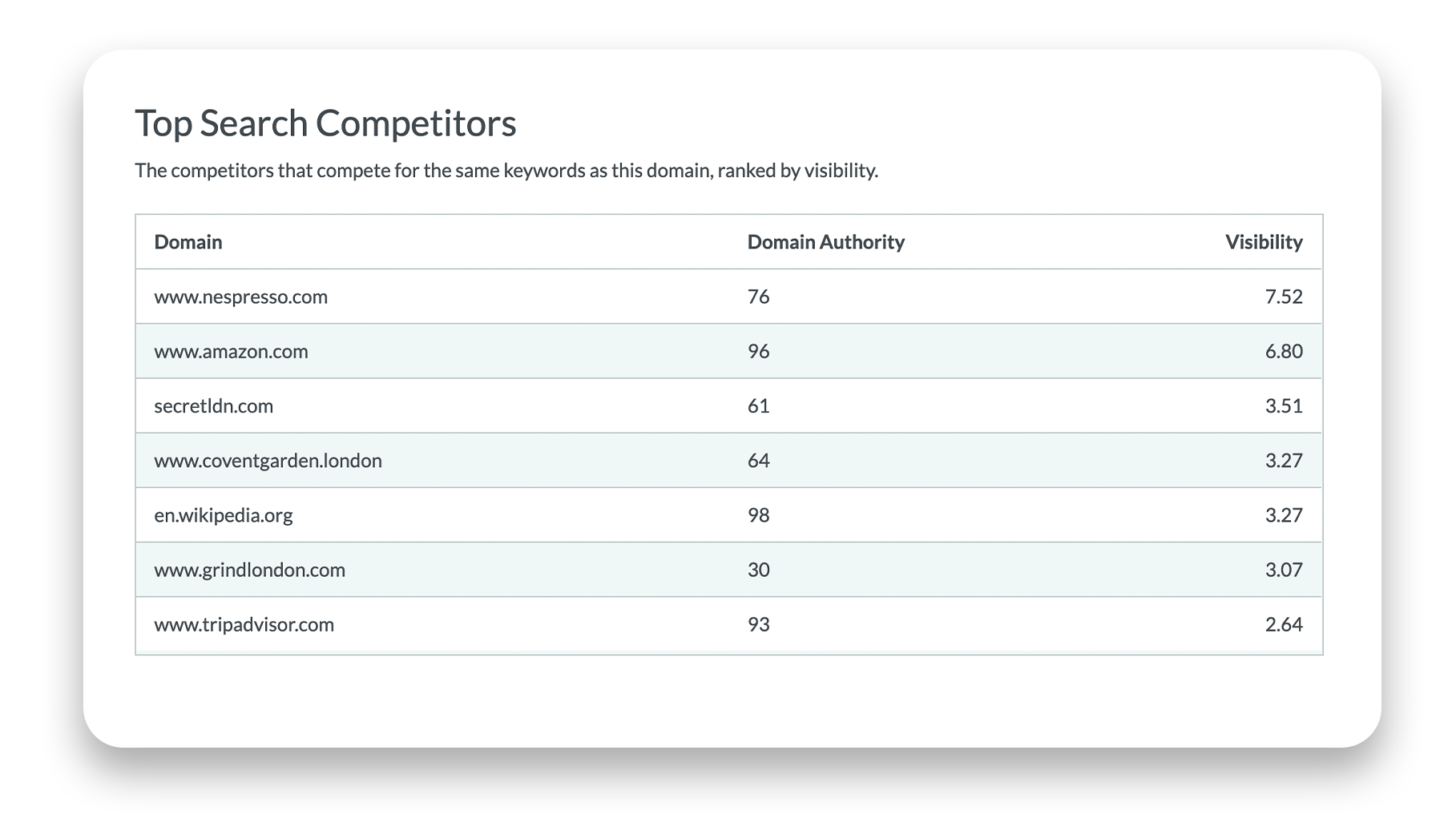
Whether you chose option 1 or 2, narrow your competitors down to a list of 10 and place these into a spreadsheet. You will then need to conduct research into the following metrics for each of your competitors, to determine the level of effort required to outperform them.
- Domain Authority
- Page Authority
- Visibility
- Referring Domains
- Backlinks
To do this, you’re going to need to understand what these metrics mean and how they can help you to figure out which of your competitors are within reach for you with a realistic amount of effort, and which are more long-term goals which require the investment of time.
- Domain Authority (DA)
This is a term created by Moz, it determines where your content ends up in the search results. The number ranges from 1 to 100; higher scores have a greater ability to rank on page 1 within Google. DA analyses your entire domain, including any subdomains like blogs or landing pages.
A considerable part of what determines a sites’ DA is the quality of your backlink profile or, in other words, how many high-quality websites link to your content.
Free tool: Moz's Domain Analysis
- Page Authority (PA)
Also developed by Moz, PA refers to how a specific page is likely to rank in SERPs; like DA, PA is scored from 1 to 100 with higher numbers equaling a higher likelihood of top rankings.
Free tool: Moz's Link Explorer - Visibility
Based on millions of data points, SISTRIX calculates the visibility of your website on a SERP by combining: “the number of keywords your page spans with the search volume on those keywords and the clickthrough rate of the position.”
Free tool: SISTRIX's Visibility Index - Referring Domains
This means the total number of unique domains that link to your domain. It is important to note that this value is different from backlinks as it only counts the domain as a whole once, even if that domain links to a website multiple times.
Free tool: Ahrefs' Backlink Checker - Backlinks
The total number of hyperlinks that point to your website. You can have multiple backlinks from one website or even from one page.
Free tool: Ahrefs' Backlink Checker
If we take the results from our option 1 analysis of The Grind and research these metrics, we should end up with something like this:

Now, don’t freak out when you see some of the huge numbers on your spreadsheet. Yes, some of the sites above have 6 figures of referring domains, but that does not mean that you have to top that just to compete!
From your chart, you will be able to divide your competitors into 2 lists: realistic and ambitious - you can do this by performing a few quick calculations to get the average, median, and minimum of each metric. For the next step, we will set aside the ambitious competitors and focus on our realistic, low-hanging fruit. 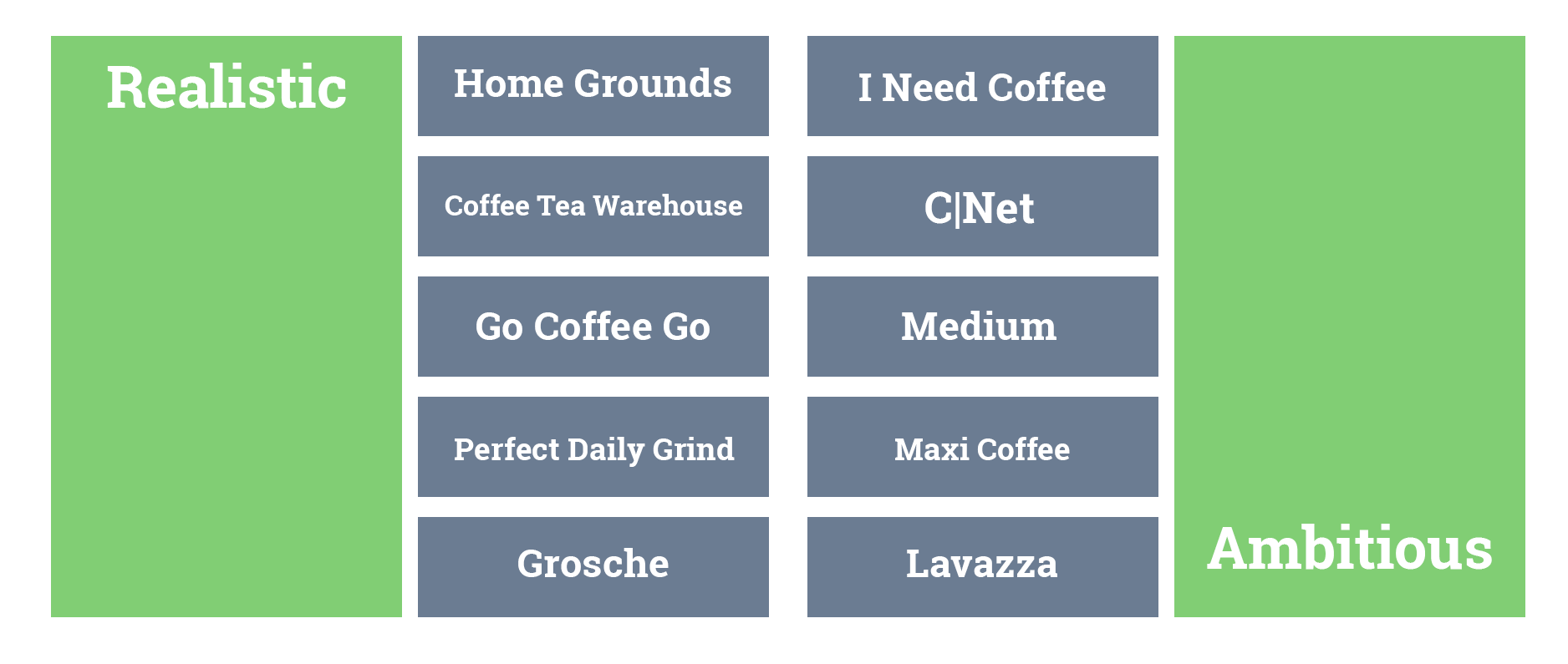
Step 3: Perform a backlink analysis

Source: Andrey Lipattsev (search Quality Senior Strategist at Google)
In our last step, we worked out the number of backlinks which our competitors have managed to achieve, now we’re going to analyse the quality of these backlinks. According to Alexa, an understanding of the status of your competitors’ backlink profile is crucial because it helps you to:
- Gain a deeper understanding of the competition within your industry
- Visualise which links are bringing your competition the most success
- Identify how to recreate your competitors’ backlink strategy and steal their traffic
If we follow SEO theory, we should be able to determine the quality of a competitor’s backlink profile by looking at the Domain Rating (DR) - a higher DR number indicates that a higher level of authority should be passed to the linked domain.
Domain ratings are scored between 1 - 100; the quality of a site's backlinks is critical as low-quality links will gain penalties. Google’s backlink penalties came forward with their Penguin algorithm in 2012 to reduce the number of spam backlinks being purchased by website owners to falsely boost their SEO. This means that a site that has a majority of low-quality links within a large backlink profile will be deemed low-value despite the sheer quantity they hold. 
Side note - don’t confuse DR with DA! DR is a metric developed by Ahrefs, which shows the strength of a website’s backlink profile, whereas DA is the metric we used in step 2, developed by Moz, that predicts how well a domain will perform on search engines.
Free tool: Ahrefs’ website authority checker
So, let’s perform our backlink analysis research for competitor number 1: Home Grounds (you will need to repeat this process for each of your competitors).
According to Ahrefs, their DR is 65, which is within the Valuable category - this means that a lot of their linking domains are high quality, so we would be wise to try to replicate their backlink strategy. To do this, we will have to dig a little deeper into who exactly is linking to their domain and what type of content is gaining them these valuable links.
To discover the valuable domains which are pointing to your competitors’ website, you can return to the Moz link explorer tool. Here you will find the referring websites, their DA score, and the top links ranked by PA. Record each of these top links within your spreadsheet and save this information for our next step.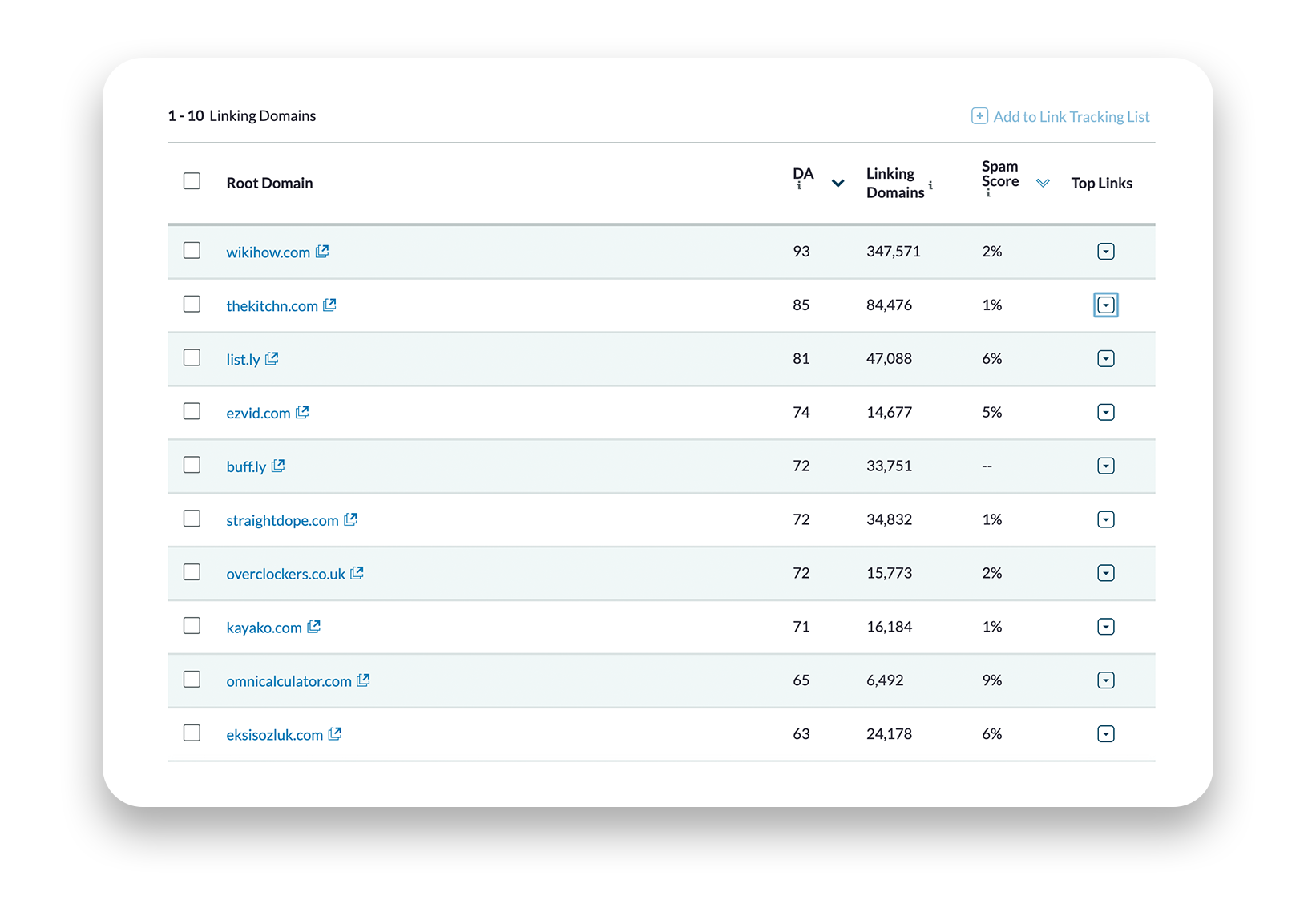
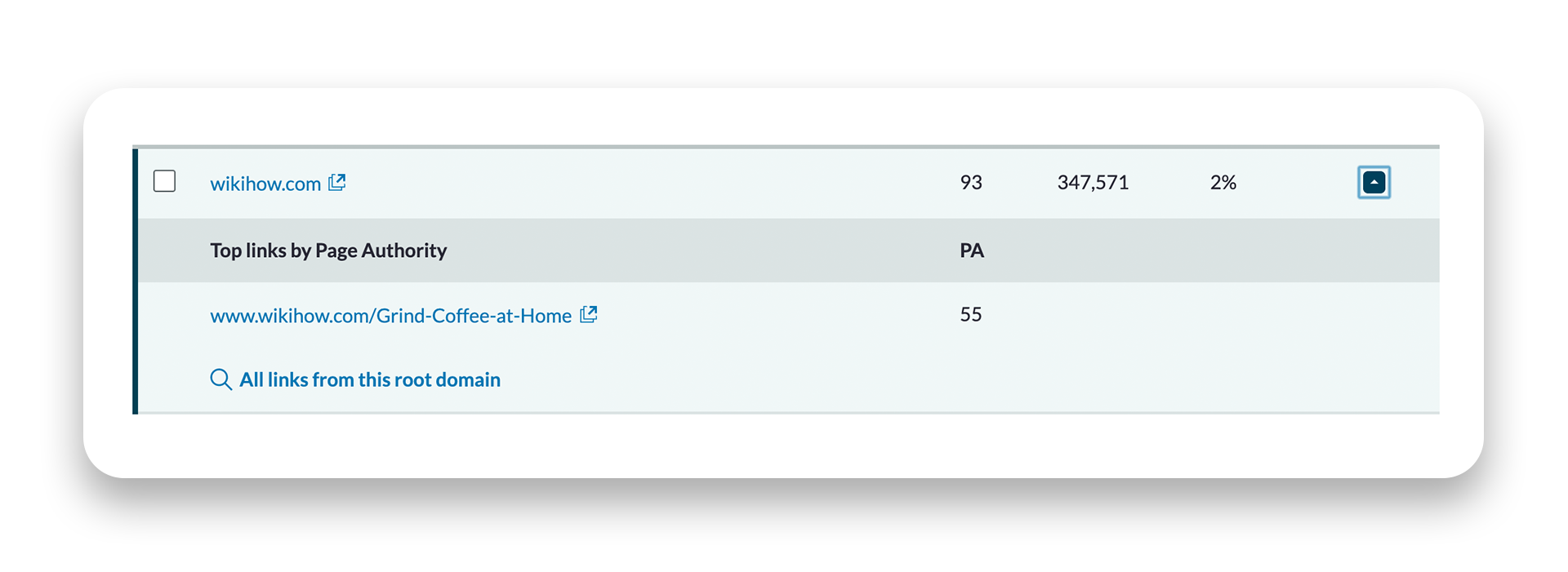
Top tip: Try to identify backlink gaps, these are sites that are linking to 2 or more of your chosen competitors. Research shows that if they already link to these similar sites and content types, they will be more likely to accept a link request from you.
Next, we want to discover which content on your competitor’s site is gaining popularity and bringing in the most backlinks. This is known as ‘Top Content’ and can be found under the tab of the same name in the Moz link explorer tool. 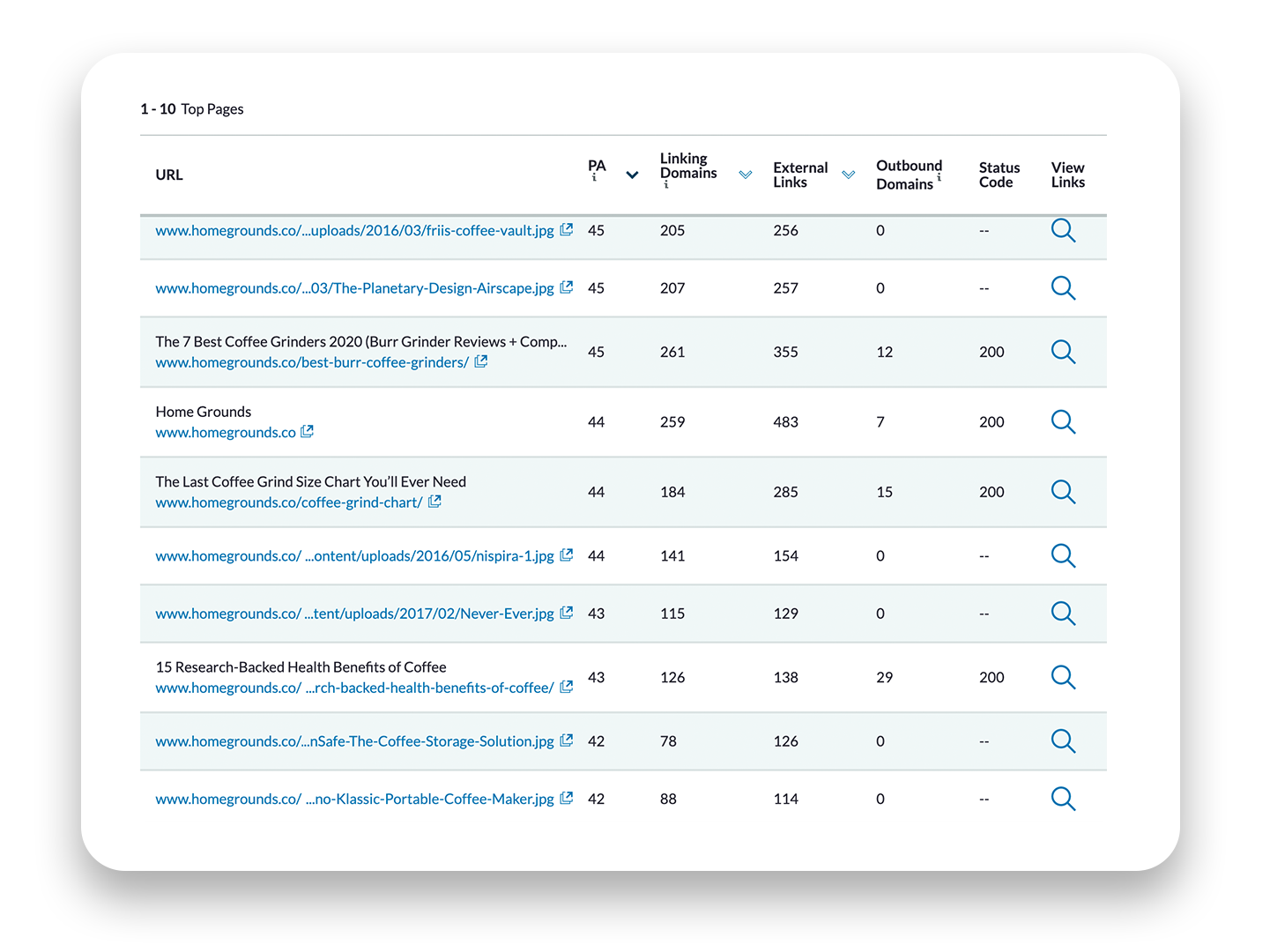
From the above analysis, we can see that 261 unique external linking domains exist for a piece of content entitled ‘The 7 Best Coffee Grinders 2020’, an in-depth listicle-format blog reviewing the top coffee grinders of the year. We can see this listicle format is repeated in another of Home Grounds’ top-performing content, so we can deduce that creating listicle-format content may be an effective way to gain valuable backlinks for this keyword.
The thing is, you don’t just want to make any old listicles, and you certainly don’t want to plagiarise your competitors' existing content! No, to steal their traffic, you will need to create a better version of what they have already published; content that offers more valuable, more insightful, and more actionable advice.
Then, using the ‘view links’ drill-down, you can see which websites you should target with your new, improved content to attempt to replace your competitor’s link with yours. Again, you should add all of this data to your spreadsheet, and perform your own research to gain contact information for the authors and content marketers at the linking sites for when you’re prepared to launch your link campaigns.
Step 4: Create & launch your backlink building email outreach campaign
I’m well aware that no one likes sending cold outreach emails; the looming sense of rejection after sending 200 emails to only receive 2 or 3 replies in return can be soul-crushing. But the great thing about conducting your SEO competitor analysis is that your outreach is far less cold than if you just generated the names of 200 random companies who write content in your area of the market.
Throughout the previous 3 steps, you have created a hyper-targeted list of potential leads. You are aware of the types of articles they write, the companies and content they link to, and what’s needed to create a better version of it for their benefit. Now you just need to communicate this benefit to them with a powerful, straightforward, and convincing email.
Hubspot has laid out 2 golden rules for backlink building campaigns:
- Only pitch backlink content that is valuable for readers
I’ll say it once again for the people at the back, don’t rewrite your competitor’s content and try to flog it to their backlinks. People won’t buy it. A fresh angle and better information equal more value for readers and an increased likelihood of gaining your backlink. - Always send individualised emails to specific publishers
No mass email blasts, please - it’s rude! Remember you’re asking these publishers for a favour in giving you a backlink. So, being polite, straightforward, and helpful will increase the likelihood of creating an ongoing lucrative SEO relationship.
Crucially, you want to make replacing your competitor’s content with your new, improved content as easy as possible, so including the correct links and directions is vital. It doesn’t matter how great you’ve made your new content if your email confuses its recipient or, even worse, is impolite or uses incorrect information.
Your email should always include:
- A greeting & brief introduction
- A clear link to the publisher’s article which you want your content to be linked within - it doesn’t hurt to mention how much you like their content (it’s nice to be nice!).
- A link to your content and an explanation of how and why it is superior to your competitors (talk about your in-depth research and new insights, don’t bad mouth your competitors).
- An offer to share the updated content with your link on social media (the publisher may appreciate an offer to return the favour and increase their reach).
So, let’s get started on our email outreach for Grind, shall we?
So here, our competitor Home Grinds’ Coffee Chart has been used in an article by The Kitchn. We have created a better version of the coffee grind chart and we are ready to offer it up to the author of the article in the hopes that she will see the value we have added and replace their link with ours. Then it’s simply a tweak, rinse and repeat process for all of the other linking domains you wish to target.
Summing Up
Whether you’re launching a new business or a new product, one of the very first things you should do is complete your competitor analysis to discover what your competitors are doing and how you can do them better. It’s business school 101. 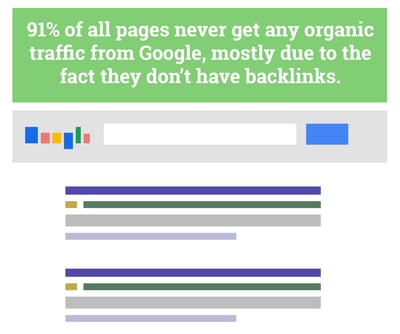
Source: Impact BND
93% of online experiences begin with a search engine. So, why is it that so many businesses are ignoring their online competitors when it comes to their digital marketing strategy and SEO? The answer: It’s a daunting task; SEO is complex, viewed as too technical and can be overwhelming if you’re not down with the lingo and tuned into the tools. But there are so many rewards to reap with just a little bit of investment into your business’s SEO competitiveness.
Performing an SEO competitor analysis will:
- Strengthen your keyword research
- Streamline your content creation
- Increase your amount of quality backlinks
- Increase your website traffic
Finally, as with all aspects of your SEO, tracking your competitors, and building quality backlinks from targeted insights is an ongoing process. Repeating this process for multiple keywords and building keyword clusters will, over time, increase your website’s authority and help you to reach the top ranking space that you deserve.
Share this
You May Also Like
These Related Stories

How to Complete Your First Competitor Analysis

What Are The Major Components of a Marketing Strategy?


